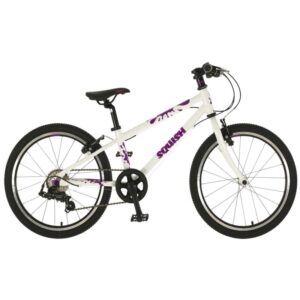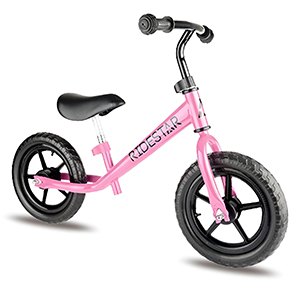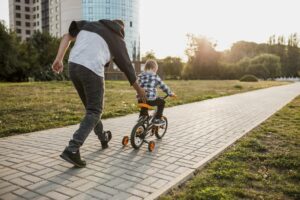Learning to ride a bike is a rite of passage for many children. It’s a skill that provides a sense of independence, freedom, and accomplishment. However, teaching a child to ride a bike can be a daunting task, especially for parents who have not experienced riders themselves. In this blog, we’ll provide the Best Tips and a step-by-step guide on how to teach a kid to ride a bike safely and confidently.
Step 1:Choose The Right Bike and Helmet
The first step in teaching a child to ride a bike is to make sure they have the right equipment. It’s important to ensure that the child can touch the ground with their feet while seated on the bike, but also that the bike is not too small or too large. A helmet is also essential for safety, as it can help protect the child’s head in the event of a fall or accident. The helmet should not be too tight and should sit level on the child’s head, covering the forehead and the back of the head.
| Chelsea Kids Bike Sizes Chart | |||
| Wheel Size | Age | Inseam | Height |
| 14″ | 2 – 4 years | 15″ – 20″ | 37 – 44″ |
| 16″ | 4 – 6 years | 16″ – 22″ | 41 – 48″ |
| 20″ | 5 – 8 years | 19″ – 25″ | 45 – 54″ |
| 24″ | 8 – 11 years | 23″ – 28″ | 49″ – 59″ |
| 26″ | 10 + years | 25″ + | 56″ + |
Step 2:Adjust the Bike To Fit Your Child
When teaching a child to ride a bike, it is important to adjust the bike to fit their size and abilities. Make sure the bike is adjusted to fit your child. This means starting with the correct size of the bike frame, seat height, and handlebar height. The child’s feet should be able to touch the ground when they are sitting on the seat and the handlebars should be at a comfortable height. You can ask about the best kid’s bike size from Chelsea’s perfect and skilled staff in the workshop or You can check it from Chelseabikes.co.uk. Chelsea Bikes shop is the best bike shop in chelsea.

Step 3:Start with Balancing a Bike
Before your child starts pedaling, when teaching a child to ride a bike, it’s important to start with balancing. Balancing is the foundation of bike riding and mastering it will make it easier for your child to pedal and steer. Start by finding a flat and open space, such as a quiet street or an empty parking lot. Have your child sit on the bike seat and place both feet on the ground. Encourage them to lift their feet off the ground and balance on the bike for as long as possible. If You need to know what is the best balancing bike for your kids then you are in a right place just visit the Chelseabikes shop and get help to buy the best balancing bike for your kid.

Step 4:Introduce Pedaling
Once your child is comfortable with balancing, Pedaling is an essential skill to teach a child when learning how to ride a bike. Once a child has mastered balancing and steering, it’s time to introduce them to pedaling. It’s important to start with flat, smooth terrain to allow the child to focus on pedaling without the added challenge of hills or obstacles. Encourage the child to keep their feet level and to push down on one pedal at a time. There are many Kids’ Bikes brands that offer paddling kids’ bikes where you can choose the best Pedaling bike for your kid.
Step 5:Practice Bike Turning and Stopping
Practice bike turning and stopping are important skills to teach a child when learning to ride a bike. Turning involves shifting weight to one side while using the handlebars to steer in the desired direction. It’s important to practice these skills in a safe environment, such as an empty parking lot or quiet street, to avoid accidents.
Step 6:Remove The Training Wheels
Removing the training wheels is a significant milestone in teaching a child to ride a bike. It’s an exciting moment for both the child and the parent, as it marks a transition from dependence to independence. The training wheels have provided the necessary stability for the child to get comfortable with the bike’s balance and movements
Step 7:Practice Bike Riding Without Training Wheels
Now it’s time to practice riding without training wheels. However, the process can be challenging for the child as they learn to balance on two wheels. This technique helps the child develop their balance and coordination skills. Start by adjusting the bike seat to a comfortable height, then have the child sit on the bike and push themselves along with their feet. Gradually encourage them to lift their feet and coast while balancing on the two wheels.
Step 8:Encourage and Praise Kids
When teaching a child to ride a bike, it’s important to encourage and praise them throughout the process. Learning to ride a bike can be a challenging and sometimes scary experience for kids, so it’s crucial to build their confidence and provide positive reinforcement. Encourage them to keep trying, even if they fall down or get frustrated. Praise them for their efforts and progress, and focus on their strengths rather than their mistakes.
Step 9:Riding Bike Practice Regularly
Regular practice is key to mastering any skill, including riding a bike. Set aside time each week for your child to practice riding their bike. Regular practice is key to becoming proficient in riding a bike. Whether you’re a beginner or an experienced rider, regular practice is essential to improving your balance, coordination, and technique. The more you practice, the more comfortable and confident you’ll become. So, grab your bike and start practicing regularly today!

Step 10:Enjoy the Bike Riding
Once your child has mastered riding a bike, it’s time to enjoy the ride! Take them on bike rides and explore new places together. Life is an adventure, and it’s important to enjoy the ride. Often, we get so focused on achieving the goals that we forget to appreciate the present moment. So, take a deep breath, slow down, and enjoy the ride. You never know what adventures lie ahead!.
Conclusion
In conclusion, teaching a child to ride a bike requires patience, practice, and a positive attitude. By following these steps, you can help your child learn to ride safely and confidently, and give them a skill that they will enjoy for a lifetime. It’s important to recognize that we don’t have to go through difficult times alone.. Asking for help is not a sign of weakness but rather a sign of strength and resilience.